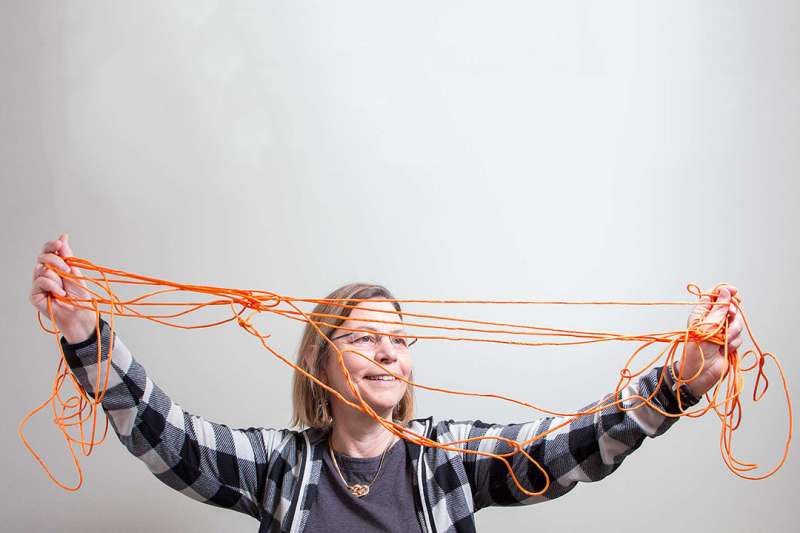A tango with tangled polymers

While statisticians are driven by real-world problems, U of S mathematics professor Chris Soteros is motivated by the more esoteric behaviour of long-chain molecules, such as polymers and DNA, and the mathematical problems they pose.
Her work involves analyzing the folding and "packaging" behaviour of these molecules. Given that two metres of DNA are folded into each cell in our body, studying the behaviour is daunting indeed.
To help unpack the problem, Soteros simplifies and simulates these molecules on a three-dimensional lattice, then uses mathematical tools such as random and self-avoiding walks to model their behaviour.
The sporadic path of a random walk is often described as "a drunkard's walk home," and is used to model random movements in large data sets—from stock market fluctuations to particle physics. A self-avoiding walk is a random walk that cannot cross the same path or retrace steps. Since no two atoms can occupy the same space, in three dimensions it is an ideal tool to model polymer behaviour.
To study polymer behaviour, Soteros models a polymer solution by using a lattice walk to represent the polymer and the empty spaces surrounding it to represent the solvent molecules of the solution.
In experimental solution at high temperatures, the polymer behaves like a self-avoiding walk. "At these temperatures, the polymer prefers to be close to the solvent molecules, but if you decrease the temperature, the polymer prefers to be closer to itself," explains Soteros.
Surprisingly, at a specific lower temperature the polymer behaves like a random walk, and below that temperature a "collapse" transition occurs, and the polymer folds in on itself.
"It wasn't until the late '70s that the collapse transition was observed in the lab, and you had to have a very large molecule in a very dilute solution to see the transition," says Soteros. "This is an example of mathematics predicting a behaviour before it was confirmed by experiments."
Sometimes theories are discovered the other way around. Former student Michael Szafron (MSc'00, BEd'09, Ph.D.'09)—now assistant professor in the School of Public Health—came to Soteros with a complex problem. Long strands of DNA can become knotted when packed into the confines of a cell nucleus, but in order to replicate successfully, DNA must be unknotted. Enzymes called type II topoisomerases perform the necessary untangling by cutting one strand of DNA, passing the other strand through the break and then reattaching the ends of the broken strand. How does this startling solution work so well, and how can it be mathematically modelled?
It helps to imagine a long necklace that has a knot; unfastening the clasp helps to untangle the knot. "The problem is that a necklace clasp could be far away from where the knot is, so it would be difficult to pull it through," says Soteros. Yet these enzymes seem to know exactly where to cut the DNA.
By modelling the basic behaviour of very large molecules in solution, Soteros is building mathematical evidence to understand how these enzymes work so efficiently—and how they might be used to develop new antibiotics and anticancer drugs.
Provided by University of Saskatchewan












.jpg)






